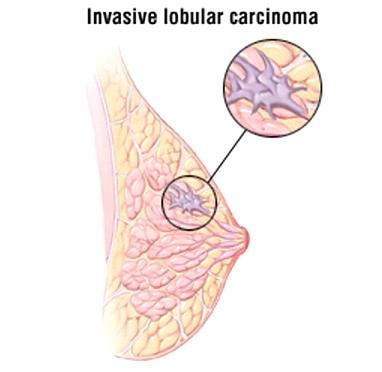Invasive Lobular Carcinoma Symptoms, Causes, Diagnosis and Treatment

What Is Invasive Lobular Carcinoma?
It is a form of breast cancer which starts in the lobules of your breast. Lobules are the glands that produce milk. ILC is also known as infiltrating lobular carcinoma. After invasive ductal carcinoma, Invasive lobular carcinoma tends to be the second most common form of breast cancer.
The word invasive connotes that the cancer has spread to the nearby breast tissues. Furthermore, lobular means that it starts to develop in your lobules responsible for producing milk, whereas carcinoma signifies any particular cancer that starts in the skin or some other tissues which cover the internal organs, for instance breast tissue.
Put together, the medical term ‘invasive lobular carcinoma’ denotes a cancer that develops in your lobules. It then penetrates its wall and spreads to the breast tissues. Gradually, it manages to spread to your lymph nodes, as well as other areas of your body.
What Are The Symptoms Of Invasive Lobular Carcinoma?
In the early stages, ILC can cause no apparent symptoms. However as it gradually develops larger, one may notice:
- A thickening area in the breast part.
- Inverted nipple.
- Swelling in breast.
- Change in the appearance or touch of your breast skin, for example thickening or dimpling.
What Causes Invasive Lobular Carcinoma?
What exactly causes invasive lobular carcinoma is a mystery till date. It starts when cells in a particular or both nodules develop mutations. Such causes the cells to produce rapidly and divide. It then penetrates its wall and spreads to the breast tissues. Gradually, the cancerous cells manage to spread to your lymph nodes, as well as other areas of your body.
What Are The Potential Complications Of Invasive Lobular Carcinoma?
Certain complications associated with invasive lobular carcinoma include:
- Spreading of cancer cells to other body areas.
- Cancer in your other breast.
What Are The Risk Factors Of Invasive Lobular Carcinoma?
A number of factors identified for increasing the chances of invasive lobular carcinoma are:
- If you are a female, than chances of developing invasive lobular carcinoma is comparatively high as compared to males.
- Older women tend to experience the particular type of cancer more, unlike the other types of breast cancer that commonly occurs in young women.
- People diagnosed with LCIS, lobular carcinoma in situ are more prone to develop invasive lobular carcinoma.
- In women, use of hormones for example progesterone and estrogen, post and throughout menopause raises the risks of invasive lobular carcinoma.
How Is Invasive Lobular Carcinoma Diagnosed?
Based on your symptoms, your doctor can suggest the following procedures and tests:
- Mammogram.
- Ultrasound.
- MRI.
- Breast biopsy.
After you have been diagnosed with invasive lobular carcinoma, the doctor will then take steps to determine the stage of cancer you have reached by now. Therefore, he or she will suggest imaging tests such as CT and MRI scans.
How Is Invasive Lobular Carcinoma Treated?
Its treatment options depend upon the following:
- Stage.
- Patient’s preference.
- Age.
- Overall health.
Usually, the treatment tends to consists:
- Surgery.
- Adjuvant (additional) therapies. These can include:
1. Chemotherapy.
2. Hormone and
3. Radiation therapy.
By : Natural Health News




